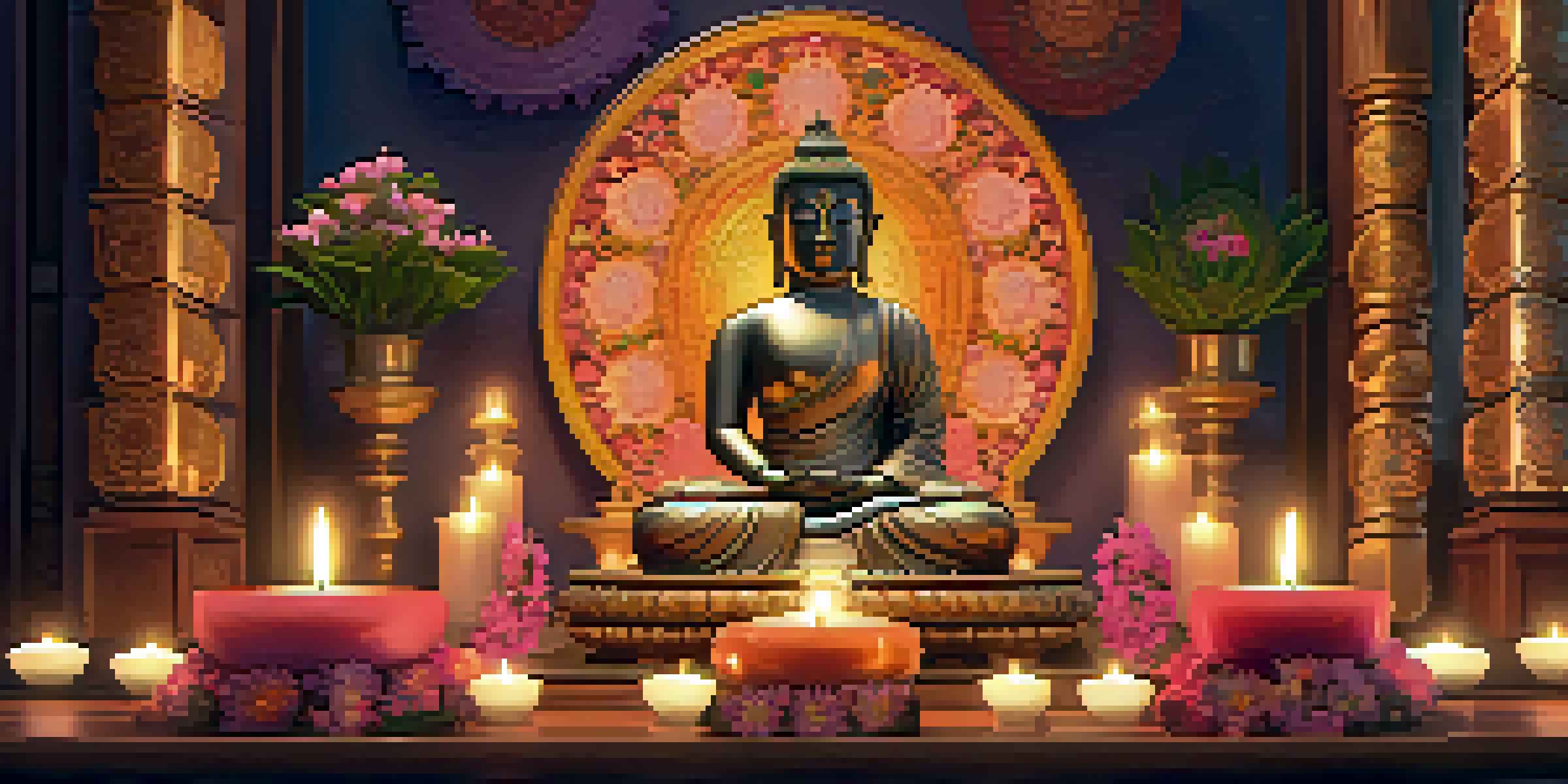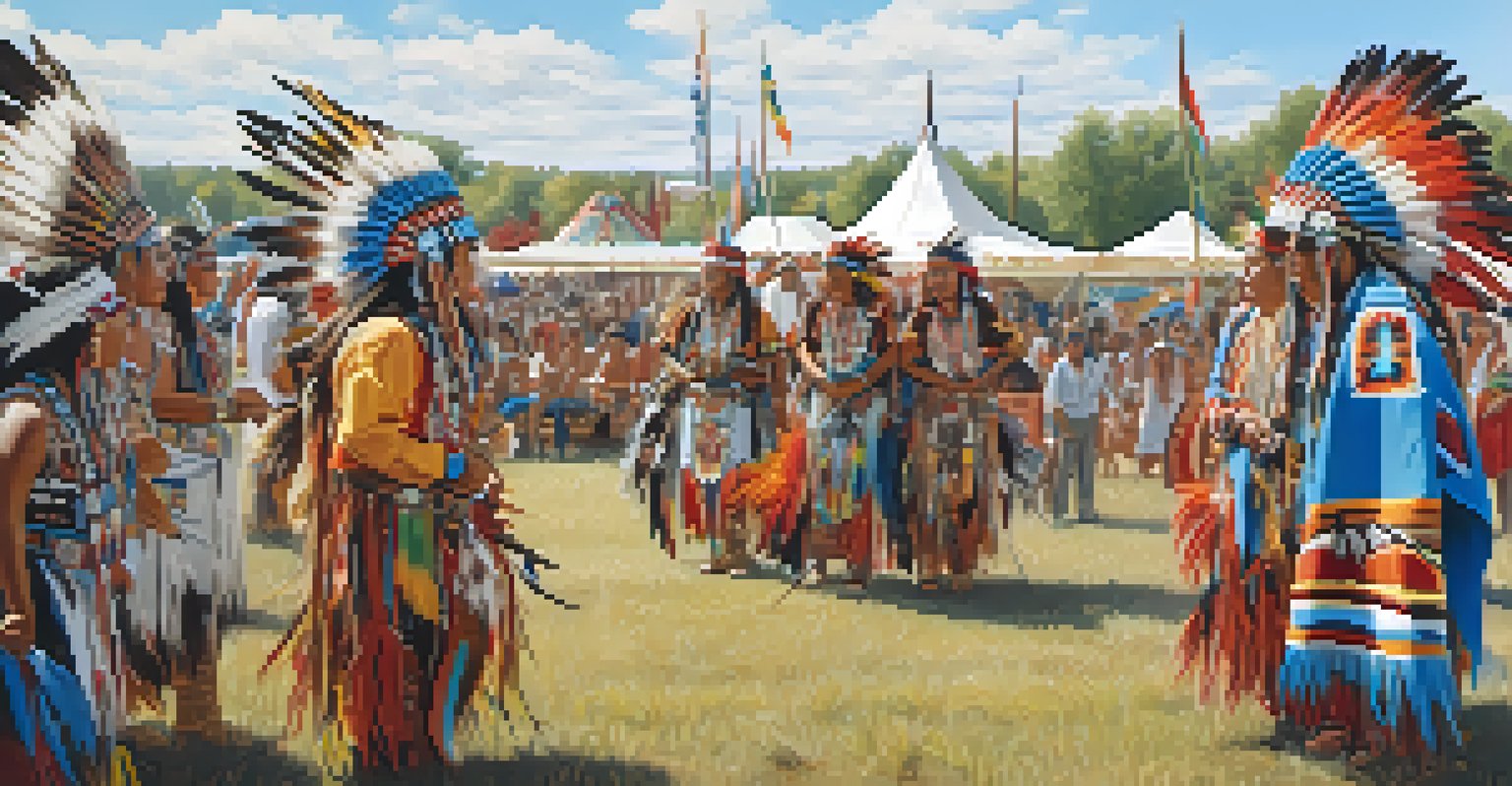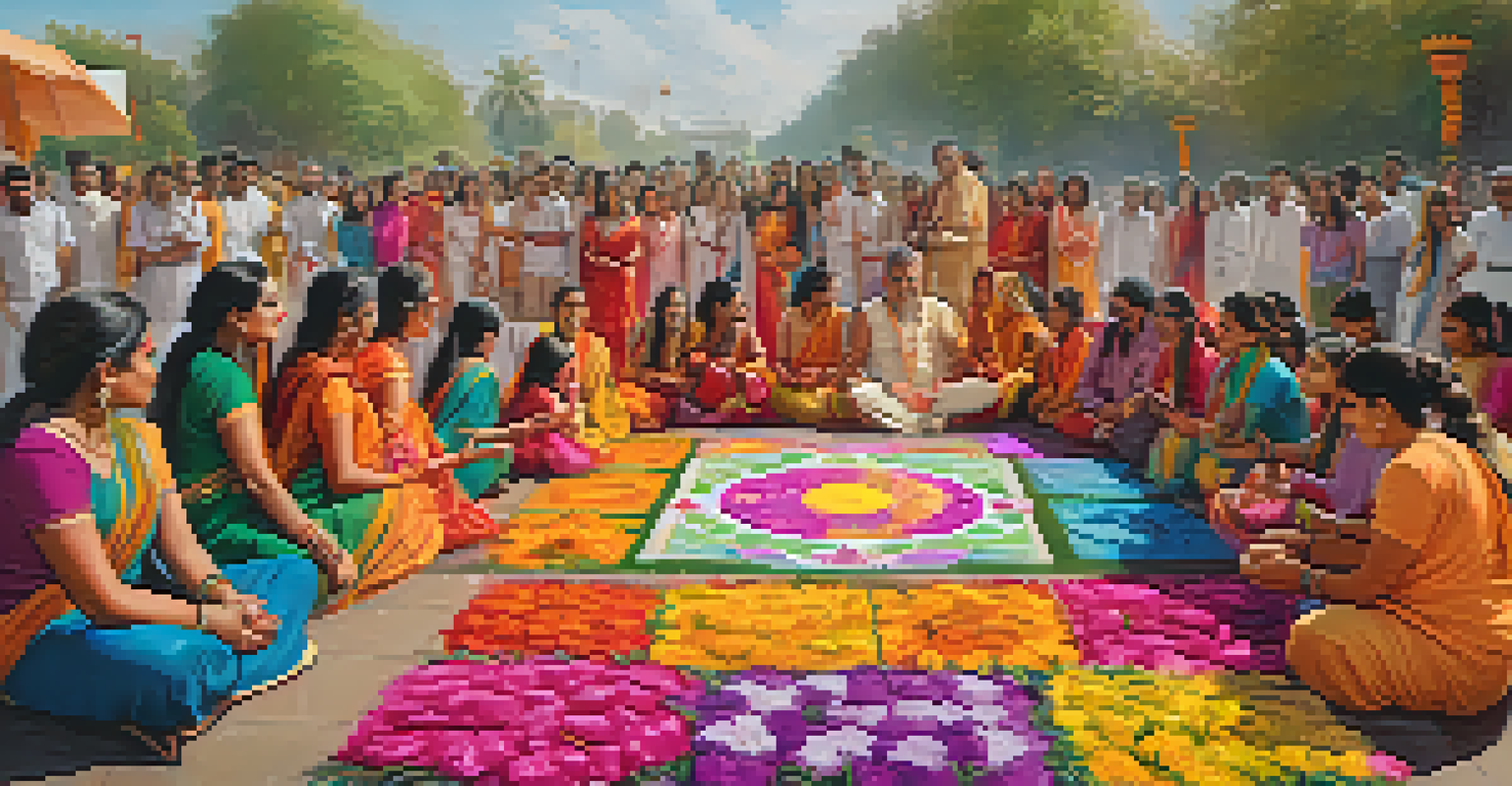The Impact of Art on the Experience of Religious Rituals

Understanding the Role of Art in Religious Rituals
Art has been intertwined with religious practices for centuries, serving as a medium through which beliefs are expressed. From intricate stained glass windows in churches to vibrant murals in temples, art creates a visual language that communicates the essence of faith. This relationship between art and religion helps participants connect more deeply with the rituals they partake in, enriching their spiritual experiences.
Art enables us to find ourselves and lose ourselves at the same time.
In many cultures, art is not merely an aesthetic addition; it plays a crucial role in the rituals themselves. For example, in Hinduism, the use of rangoli (colorful floor designs) during festivals enhances the atmosphere, making the ritual feel more vibrant and alive. Such artistic expressions resonate with the community's beliefs and traditions, fostering a sense of belonging and shared identity.
Moreover, the emotional impact of art can elevate a ritual from a mere routine to a transformative experience. When participants encounter beautiful art, they often feel a sense of awe and reverence, which can deepen their engagement with the ritual. This emotional connection is vital, as it helps individuals internalize the spiritual significance of their practices.
Art as a Medium for Cultural Expression in Rituals
Cultural identity often finds its voice through art, particularly in religious rituals. Each community brings its unique artistic styles, symbols, and narratives to its practices, making rituals a canvas for cultural storytelling. For instance, Native American powwows incorporate traditional dance, music, and visual art, reflecting the community’s history and spiritual beliefs.

Artistic expressions in rituals help preserve cultural heritage, passing down traditions through generations. When participants engage with these art forms, they not only honor their ancestors but also embrace their identity. This cultural continuity fosters a sense of pride and belonging, reinforcing the community's spiritual bonds.
Art Deepens Spiritual Connection
Art enhances the emotional engagement of participants in religious rituals, fostering a deeper understanding and connection to their faith.
Additionally, art can challenge and evolve cultural narratives within religious contexts. As artists reinterpret traditional themes, they invite new conversations and perspectives, allowing rituals to adapt and resonate with contemporary audiences. This dynamic relationship between art and culture enriches the ritual experience, making it relevant and meaningful.
Sensory Engagement: Art's Role in Enhancing Rituals
Art engages multiple senses, creating a more immersive experience during rituals. The sights of vibrant colors, the sounds of music, and even the scents of incense or flowers combine to envelop participants in a unique atmosphere. This sensory engagement can lead to heightened awareness and a deeper connection to the spiritual dimensions of the rituals.
The essence of art is to be a medium for the spiritual, the emotional, and the cultural expressions of humanity.
For example, in Buddhist ceremonies, the combination of intricate mandalas, chanting, and fragrant offerings serves to stimulate the senses, inviting participants into a meditative state. Such engagements can facilitate a shift in consciousness, allowing individuals to transcend everyday distractions and enter a space of reflection and devotion.
Furthermore, this multi-sensory approach can cater to diverse preferences and learning styles among participants. By appealing to different senses, art ensures that everyone can find a personal connection to the ritual, enhancing individual and communal experiences alike.
Symbolism in Art: Deepening Spiritual Understanding
Art often employs rich symbolism, which can deepen participants' understanding of spiritual concepts during rituals. Symbols can convey complex religious ideas in an accessible way, making them easier to grasp and reflect upon. For instance, the lotus flower in various Asian religions symbolizes purity and enlightenment, serving as a powerful reminder of spiritual growth during rituals.
As participants engage with these symbols, they may find personal interpretations that resonate with their own spiritual journeys. This reflective process can lead to profound insights, fostering a deeper connection to the ritual's meaning. Art thus acts as a bridge between the tangible and the intangible, facilitating a richer exploration of faith.
Cultural Identity Through Art
Art serves as a canvas for cultural storytelling in rituals, preserving heritage and reinforcing community bonds.
Moreover, the use of symbolism in art can encourage dialogue and community engagement. When individuals share their interpretations of symbolic elements, it opens avenues for deeper conversations about beliefs and values, enriching the communal experience. This exchange can strengthen bonds among participants and enhance the overall impact of the ritual.
Art's Ability to Inspire and Uplift During Rituals
Art has a unique power to inspire and uplift the human spirit, particularly during religious rituals. Beautifully crafted objects, music, or performances can evoke feelings of hope, joy, or serenity, transforming the atmosphere of a gathering. This uplifting quality can be especially impactful during times of mourning or hardship, providing solace and encouragement to participants.
For example, during a memorial service, the presence of meaningful art—be it photographs, paintings, or music—can help commemorate lives and evoke cherished memories. This creative expression offers a space for collective mourning while simultaneously celebrating life, fostering a sense of healing and unity among attendees.
Additionally, artists often draw upon their spiritual experiences to create work that resonates with others. This shared sense of inspiration can spark motivation and encourage individuals to reflect on their own spiritual practices. In this way, art not only enhances the ritual experience but also empowers individuals to explore their faith more deeply.
Community and Connection: Art in Collective Rituals
Art plays a vital role in fostering community and connection during collective rituals. When individuals come together to create or experience art, it strengthens social bonds and cultivates a sense of belonging. Rituals that incorporate communal artistic expressions, such as group singing or collaborative art-making, encourage participants to share in the experience and connect on a deeper level.
For instance, many religious festivals involve community art projects, where participants contribute to a larger creation. This collaborative effort not only enhances the ritual's significance but also symbolizes unity and shared purpose within the community. Such collective creativity can lead to lasting friendships and support networks, reinforcing the social fabric of the group.
Community Building via Collective Art
Engaging in communal art activities during rituals strengthens social ties and promotes inclusivity among diverse participants.
Moreover, the communal aspect of art in rituals can transcend individual differences, promoting inclusivity and understanding. When people from diverse backgrounds come together to celebrate their shared beliefs through art, it fosters a spirit of acceptance and cooperation, enriching the overall ritual experience.
Conclusion: The Enduring Impact of Art on Ritual Experiences
In conclusion, the impact of art on the experience of religious rituals is profound and multifaceted. From enhancing emotional engagement to fostering community connections, art serves as a vital component that enriches these sacred practices. As participants immerse themselves in artistic expressions, they often find deeper meanings and connections to their spirituality.
The interplay between art and ritual invites individuals to explore their beliefs, engage with their communities, and reflect on their personal journeys. As societies continue to evolve, the role of art in religious rituals will undoubtedly adapt, finding new ways to inspire and uplift participants.

Ultimately, the enduring connection between art and religious rituals highlights the shared human experience of seeking meaning and belonging. By embracing this dynamic relationship, communities can continue to create rich, transformative experiences that resonate across generations.